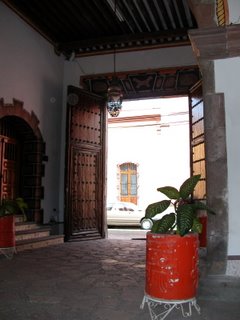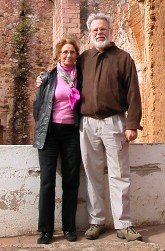I walked down to the Cruz market and then another block beyond to the Peace Corps office. Are we centrally located or what?
Byron, the in-country director to whom we had been introduced by Maria, was out visiting volunteers so I talked to his secretary, Regina. A five minute talk turned into a forty-five minute talk. I wanted to find out what the Peace Corps was doing in Mexico (the program is brand new in Mexico), and to see if we could work out a Peace Corps appearance for the Moroccan Peace Corps reunion I am helping to prepare in a year or two. However, we immediately got side-tracked to other things.
It turns out that Regina, has a mother who is an archaeologist, probably the first female Mexican archaeologist. She is in her 80s and worked at two of the most important archaeological sites in Mexico, Tzintzuntzan on Lake Patzcuaro, one of the few Purepecha (not Aztec) contact sites ever worked on, and Chupicuaro, the type site for the Preclassic in that part of Mexico, known for its figurines that have become Preclassic time markers. She was the only Mexican woman archaeologist back in the 1940s. Later she worked at the Templo Major in Mexico City with Eduardo Matos, the grand old man of Mexican Archaeology. I was, needless to say, very, very impressed.
Our conversation got around to what I would be doing in Mexico. Regina suggested I join the Peace Corps again, and while I did not flat out refuse, I was more interested in volunteer opportunities in Querétaro. She loaded me up with all sorts of suggestions from working with Consejos de Ciudadanos (citizens councils for local people to help the city and state solve some of its problems) to maybe working with Peace Corps volunteers in some capacity. In the course of the conversation, I mentioned ICOMOS (UNESCO’s International Council on Monuments and Sites), of which I have been a member for several years, and on which I serve as a member of the Archaeological Heritage Management Committee, both in the US and internationally. Turns out she knows someone on the Querétaro committee of ICOMOS, and gave him a call. She then passed me the phone. A little flustered, I set up a meeting at 7 in the evening to meet Victor, an architect, and his wife at Las Torrihas, a restaurant on Plaza de Armas (see above/below), and the only place I could think of on the spur of the moment.
That afternoon, C and I took a two hour bus tour of Querétaro (see below), visited the bank for more dinero, and bought a holder for my cell phone. At 7 we were at the restaurant waiting for a guy who had a beard (sounds familiar). Soon thereafter, Victor showed up and brought along some friends, Jorge, a lawyer, and his wife Elena. Jorge and Elena live about a block and a half away and are also knowledgeable about historic preservation.
Victor’s wife, Patricia, who is a graphic artist by trade, came later since she teaches an art class for fun after work. Everyone spoke English, Elena is from Brownsville, but it was agreed that the conversation would be in Spanish until I ran out of vocabulary. Luckily, that really never happened. I was in my element, talking about Mexican archaeology and historic preservation with people who knew what I was talking about.
Turns out Victor also has a degree in archaeology, has been very involved in historic preservation in Querétaro and even headed up the local preservation enforcement arm (a bit more important than the Dekalb County Historic Preservation Commission that I was briefly president of), is an architect interested in fixing up old colonial homes in the historic district with an office a block away from the hotel we had stayed in, and he knew two of my main professors, Peter and Paul Schmidt (they are not related). Paul is still an archaeology professor at the University of Mexico (UNAM), and Peter is, or was, the head of the National Institute of Anthropology and History (INAH) in Merida, Yucatan. Talk about a coincidence.
Victor also knew some of the ICOMOS people I know (although not well), such as Nelly Robles in Oaxaca. Serendipity. We had, as you must understand, a really interesting conversation. We even got into a discussion of Machu Pichu and Cuzco (two of my favorite places), where Victor had helped represent Querétaro at an international meeting of World Heritage Cities. Jorge was funny and will be a real delight to get to know. Meantime, C was talking to Paty and Elena and got invited to a class Lena attends, to meet other Mexican women and find out what volunteer opportunities there are available.
Victor snuck behind our backs and paid the tab, so I now owe him one, or maybe two; but we had a really great time, and found out more in 2-3 hours than we ever could from a book or just wandering around. Victor even offered to help me navigate the DF when I make my obligatory visit to Paul Schmidt at UNAM. Can you tell I am elated?
Here are some pictures that did not fit anywhere else.
 View from the kichen window of my new bougainvilla and geraniums we bought on the road between Toliman and Colon last weekend. Helps relieve the monotony of the ochre wall; and besides, gotta grow things.
View from the kichen window of my new bougainvilla and geraniums we bought on the road between Toliman and Colon last weekend. Helps relieve the monotony of the ochre wall; and besides, gotta grow things.
Patio of the Peña y Peña house where the President of Mexico of the same name lived when he signed the Treaty of Guadalupe Hidalgo ceding over half of Mexico to the US in 1848. The Library of Congress noted parenthetically that this territory which included California, Santa Fe, Texas, etc. was "(regarded by Mexicans as their territory)". Who says the Library of Congress isn't even handed. We called it Manifest Destiny, they called it imperialism. This was before Maximillian showed up. It is also the house where Christiane is taking the classes Elena introduced her to. Her class is held in the office right in the middle of the picture. BTW, Mexicans say that the treaty was OK because now they are taking it all back anyway despite Tom Tancredo and Congress (joke, guys, just a joke).

Door to the street of the Peña y Peña house. The detailing is pretty neat. The red pots have Tlaloc (Aztec rain god) on them.

No comments:
Post a Comment